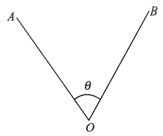Suppose an angle AOB is to be measured. The following procedure is adopted:
- The instrument is set up over O. It is centred and levelled perfectly
consistent with the procedure described for temporary adjustment. Suppose the instrument was initiallywithin the face left position. - The lower clamp is kept fixed. The upper clamp is loosened, and by turning the telescope clock-Wise vernier A
is about to 0 and vernier B to approximately 180°. The upper clamp is then tightened. Now by turning the upper tangent screw, verniers A and B are setto precisely 0 and 180° byrummaging through thehand glass . - The upper clamp is tightly fixed. The lower one is loosened and the telescope is directed to the left-hand object A. The ranging rod at A is bisected approximately by properly focussing the telescope and eliminating parallax. The lower clamp is tightened, and by turning the lower tangent screw the ranging rod at A is accurately bisected.
- The lower clamp is kept fixed. The upper clamp is loosened and the telescope is turned clockwise to approximately bisect the ranging rod at B by properly focussing the telescope. The upper clamp is tightened, and the ranging rod at B bisected accurately by turning the upper tangent screw.
- The readings on verniers A and B are noted. Vernier A gives the angle directly. But
within the case of vernier B, the angle is obtained by subtracting the initial reading fromthe ultimate reading. - The face of the instrument is changed and the previous procedure is followed. The readings of the verniers are noted
within the table. - The mean of the observations (i.e. face left and face right)
is that the actual angle AOB. The two observations are taken to eliminate any possible error due to imperfect adjustment of the instrument.
The vertical angle is the one between the horizontal line (i.e. line of collimation)
- The theodolite is set up at O. It is centred and levelled properly. The zeroes of the verniers (generally C and D) are set at the 0°-0° mark of the vertical circle (which is fixed to the telescope). The telescope is then clamped.
- The plate bubble is brought to the centre with the help of foot screws (in the usual manner). Then the altitude bubble is
delivered to the centre by means of a clip screw. At this positionthe road of collimationis strictly horizontal. - To measure the angle of elevation, the telescope is raised slowly to bisect the point A accurately. The readings on both the verniers are noted,
and therefore the angle of elevation recorded. - The face of the instrument is changed and the point A is again bisected. The readings on the verniers are noted. The mean of the angles of the observed is assumed to be the correct angle of elevation.
- To measure the angle of depression, the telescope is lowered slowly and the point B is bisected. The readings on the verniers are noted for the two observations (face left and face right). The mean angle of the observation is taken to be
the right angle of depression.











